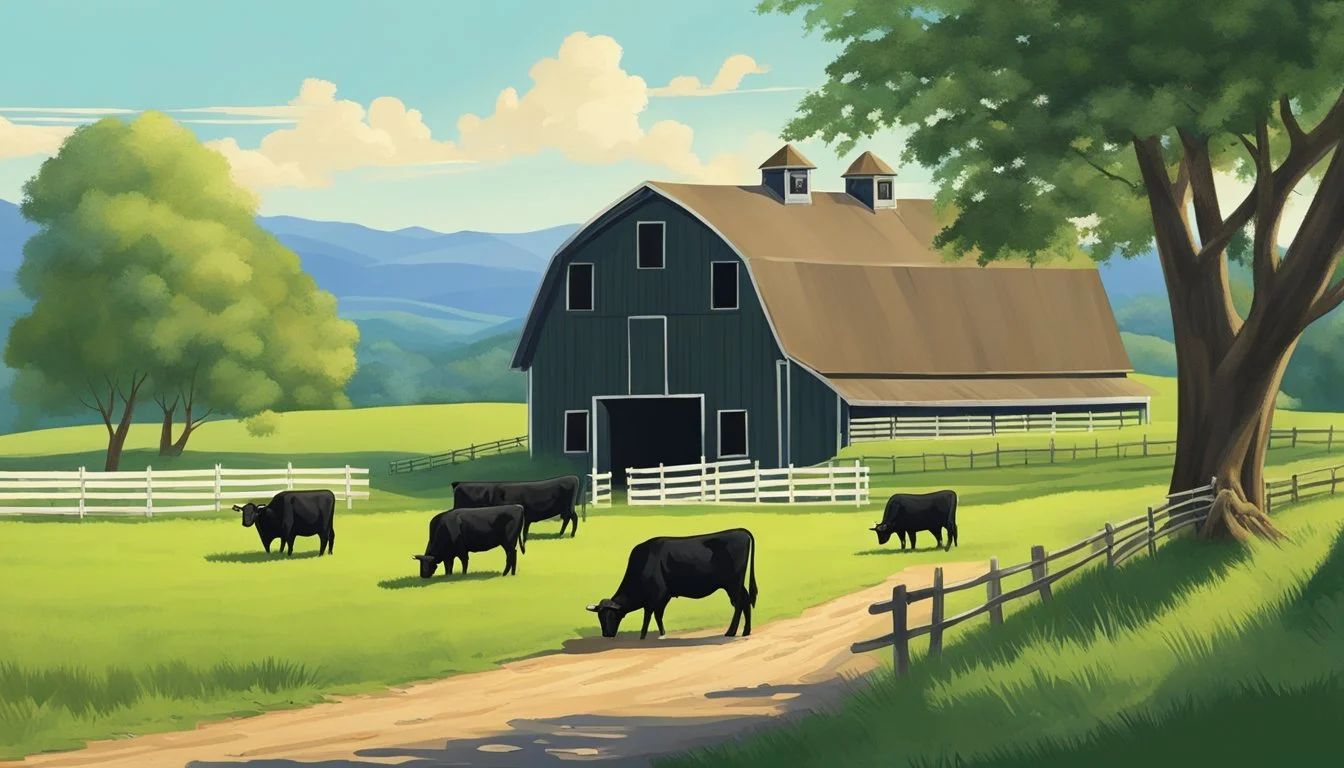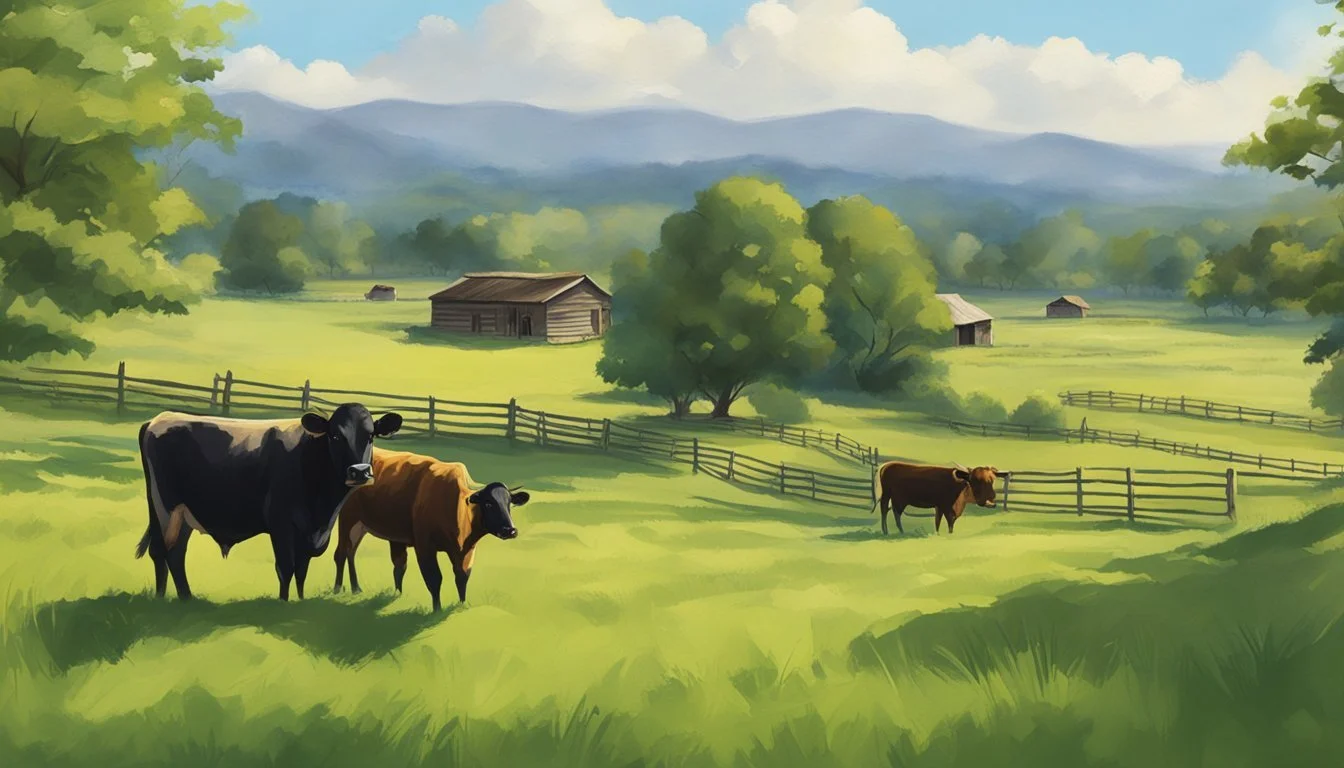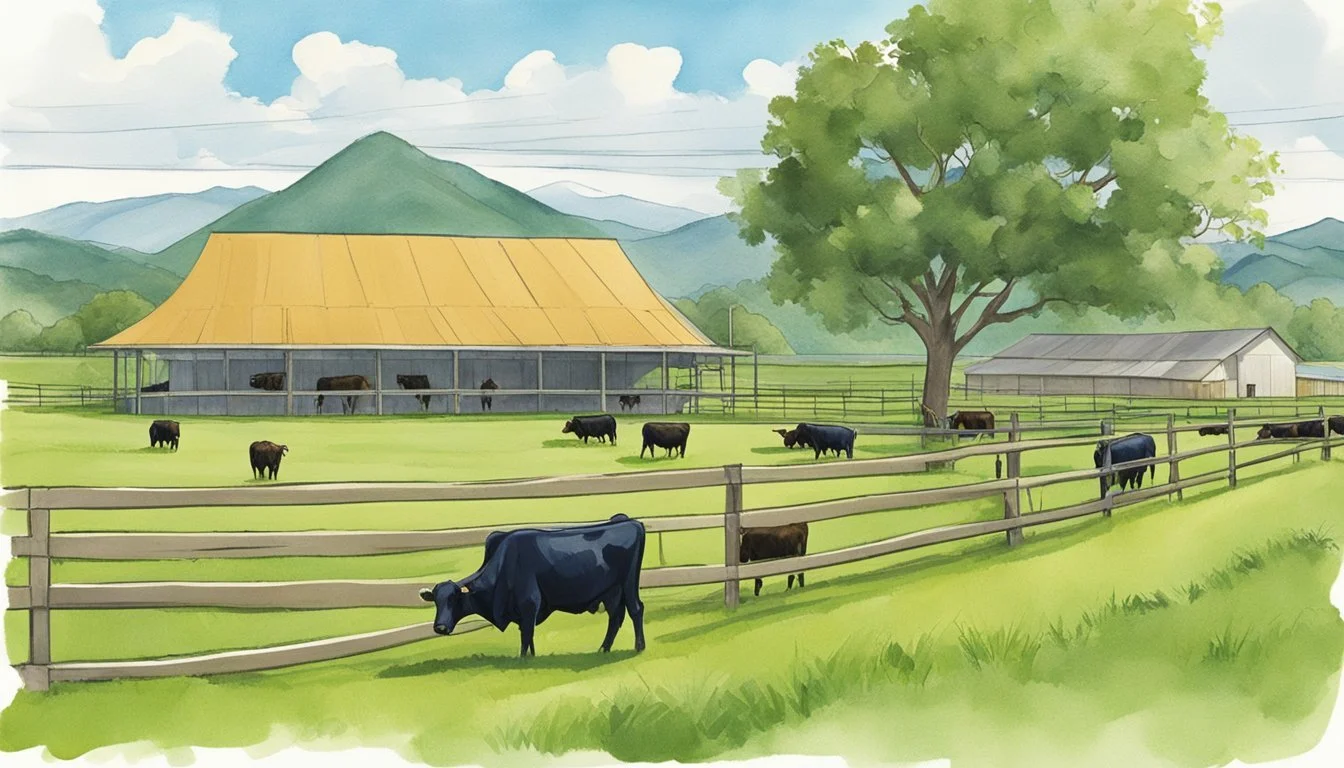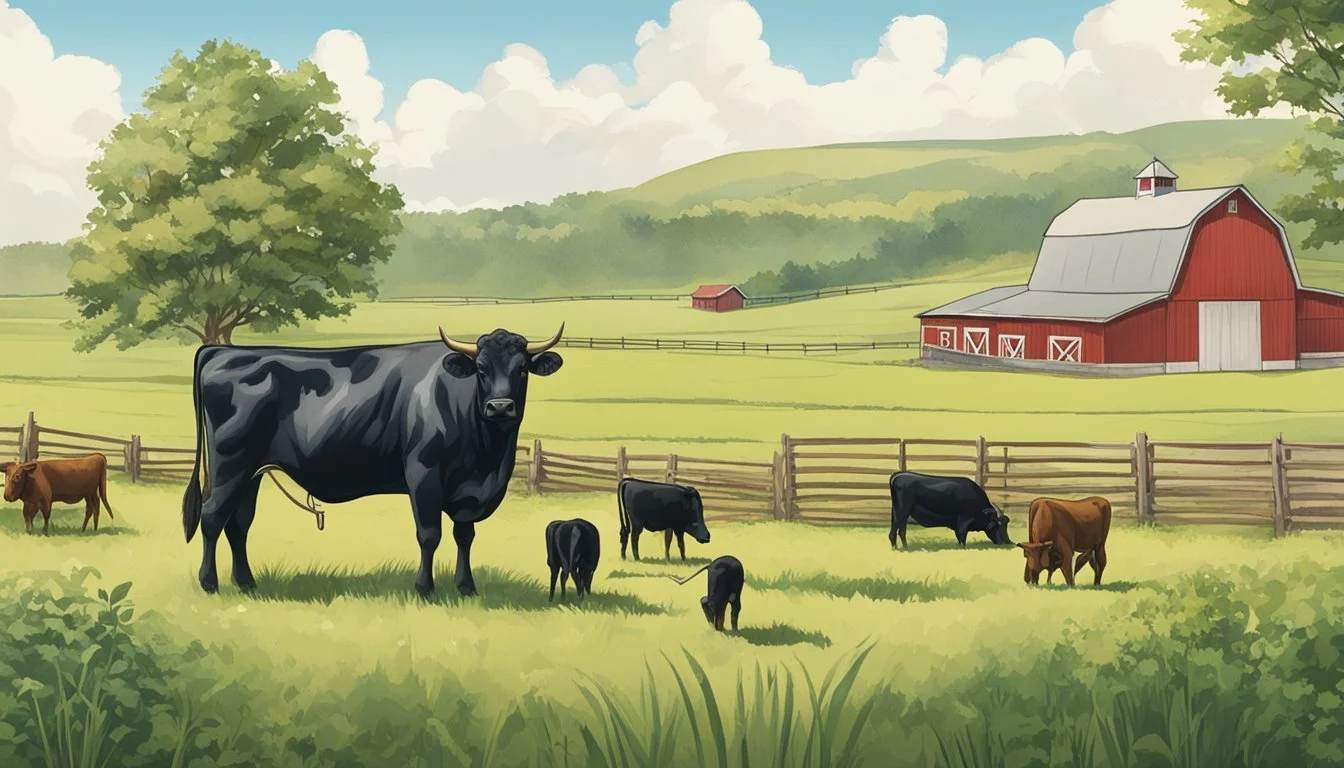Building a Sustainable Dexter Cattle Breeding Program
Key Strategies for Homesteading Success
Dexter cattle, originally from Ireland, have garnered attention as a sustainable option for small-scale homesteading. Dexter cows are one of the smallest cattle breeds, and their compact size makes them an ideal choice for a homestead with limited land. They are recognized for their hardiness, early maturity, and ability to thrive on less pasture compared to larger breeds, thus promoting a more sustainable form of agriculture. With a mature cow weighing between 600 to 700 pounds on average, and bulls slightly larger at 900 to 1,000 pounds, Dexters are easier to handle and less impactful on the pasture, reducing the potential for overgrazing and land degradation.
Breeding Dexter cattle on a homestead can contribute to the maintenance of this heritage breed while also supporting sustainable agricultural practices. Given their smaller size, they require less feed, produce less manure, and are efficient milk and meat producers, which underscores their role in a closed-loop farming system. Homesteaders have found that the breed's docile temperament and manageable size enhance the feasibility of integrating Dexters into a family-run sustainable breeding program.
Implementing a Dexter cattle breeding program requires an understanding of genetic diversity, hereditary traits, and breeding cycles. Sustainable breeding practices focus on maintaining the health and welfare of the cattle, as well as ensuring the longevity and productivity of the herd. Homesteaders dedicated to sustainable farming recognize the value of Dexters in achieving these goals and work towards optimizing breeding strategies that align with ecological balance and the conservation of resources.
Origins and History of Dexter Cattle
The Dexter breed, named after its native landscape in Ireland, owes its survival and proliferation to strategic breeding and a rich heritage. This section will explore the deep Irish roots of Dexter cattle and their expansion across the Atlantic to America, highlighting key historical figures like Lord Hawarden of Valentia Island.
Irish Roots and Expansion to America
Dexter cattle trace their lineage to the southwestern regions of Ireland, with early records indicating their prominence in County Tipperary and County Kerry. This breed was developed in the early 19th century by small-scale farmers who required versatile and hardy cattle for both milk and meat within limited land areas.
Native Home: Ireland
Primary Use: Dual-purpose (milk and meat production)
Characteristics: Small stature, hardiness, adaptability to the Irish landscape
These cattle quickly became known for their efficiency and adaptability, qualities that led to the breed's importation to America. The late 19th century saw the arrival of Dexter cattle in the United States, primarily brought over by Irish immigrants who valued the breed's unique characteristics.
Importation to America: Late 19th century
Reason: Recognized value by early Irish immigrants
Result: Establishment of Dexter cattle herds across the country
The Role of Lord Hawarden and Valentia Island
One pivotal figure in the spread of Dexter cattle was Lord Hawarden. This influential lord was known for his estate on Valentia Island in County Kerry, a place pivotal in the breed's history due to its role as a significant breeding and exporting center.
Lord Hawarden: Key figure in the breed's history
Valentia Island: Significant in the promotion and exportation of the breed
Contributions: Lord Hawarden's estate served as a crucial link in refining and disseminating Dexter genetics
The Dexter Cattle Society, established in the UK, further reinforced the breed's prominence. It dedicated itself to the promotion of Dexter cattle, marked by its transition to an exclusive focus on the breed in 1924 and the significant increase in recorded animals by 1926.
Dexter Cattle Society Formation: 1924, exclusive promotion of Dexter cattle
Herd Book Records (as of 1926): 986 bulls and 3,896 cows since 1892
The insights from Lord Hawarden's estate and the push from the society contributed vitally to spreading Dexter cattle beyond their Irish origins into new lands, including America, laying the groundwork for a sustainable breeding program rooted in a deep history.
Breed Characteristics and Standards
Dexter cattle are renowned for their versatility as a tri-purpose breed, offering benefits in beef, milk, and draft. They have distinct physical characteristics and genetic traits that are essential for maintaining the breed's standards and ensuring the sustainability of a breeding program.
Physical Conformation and Coat Colors
Dexter cattle exhibit a compact body structure essential for their dual-purpose role in both beef and dairy production. Physical conformation is vital for the soundness and efficiency of these animals. Breeders should look for a short, broad head that tapers gracefully towards a broad muzzle. Cows typically stand between 38 and 44 inches at the rump, while bulls are between 42 and 48 inches. The eyes should be bright and prominent, demonstrating the breed's renowned alertness.
When it comes to coat colors, Dexter cattle come primarily in three solid colors: black, red, and dun. An occasional white marking may appear, but the breed standard requires predominantly solid colors to maintain uniformity within the breed.
Genetic Traits and Breed Standard Compliance
Chondrodysplasia, or dwarfism, is a genetic trait to be aware of within Dexter cattle. Breeders must employ DNA tests to identify carriers and plan matings that avoid propagating this trait, ensuring the well-being of the breed. Compliance with the breed standard is not just about physical attributes; it includes managing hereditary conditions responsibly.
A commitment to maintaining genetic health and conformation within the guidelines set by Dexter cattle associations will contribute to a sustainable breeding program. Genetic diversity is an essential consideration for breeders, as it helps to maintain a robust and productive breed population.
Understanding Dexter Cattle Temperament and Behavior
Dexter cattle are renowned for their manageable size and good nature, traits that benefit homesteaders looking for a breed easy to handle and care for.
Gentle Temperament and Handling Ease
Dexter cattle typically exhibit a gentle temperament, making them an excellent choice for those with less experience in cattle management. Their calm demeanor translates into ease of handling, which is particularly advantageous for activities such as milking, feeding, and routine veterinary care. Homesteaders value these characteristics as they allow for more efficient livestock management and reduce the risk of injury to both the handlers and the animals.
Behavioral Traits of Bulls and Cows
Behaviorally, Dexter bulls and cows present some differences that are important to recognize for a sustainable breeding program. Dexter bulls are generally amiable, but like all bulls, they require careful handling and should not be underestimated, especially during the breeding season when their behavior can become more assertive. Dexter cows, on the other hand, are known for their nurturing instincts and typically show a protective attitude towards their calves. However, their gentle nature means they interact well with humans, which can ease the processes of calving and calf management for the breeder.
Sustainable Breeding Practices for Dexter Cattle
In establishing a sustainable Dexter cattle breeding program, it is essential to prioritize genetic diversity and fertility while also proactively preventing common breeding challenges. Effective breeding practices contribute significantly to the long-term viability of livestock and align with the principles of sustainable agriculture.
Enhancing Genetic Diversity and Fertility
To maintain a robust breeding program, preserving genetic diversity is critical. It ensures a wide range of genes that can lead to improved fertility, disease resistance, and adaptability to changing environmental conditions.
Select Breeding Stock: Choose a diverse group of breeding stock to prevent inbreeding depression. This broadens the genetic base and supports sustained fertility rates.
Monitor Breeding Pairs: Carefully record and monitor breeding pairs and their offspring to track genetic variances and enhance breed characteristics.
Periodic Assessment: Frequently evaluate the herd's fertility and genetic health, and adjust breeding strategies as needed.
Preventing Common Breeding Challenges
Breeding Dexter cattle comes with its set of challenges, such as calving difficulties, which can undermine the sustainability of the program.
Birth Weight Management: Manage the breeding process to avoid high birth weights, which can complicate delivery.
Guidelines: Implement feeding and health protocols that aim to optimize birth weights.
Regular Health Checks: Schedule routine health checks to identify and address any potential reproductive health issues early.
Best Practices: Stay informed with the latest breeding best practices to mitigate risks to both cows and calves.
Data-Driven Decisions: Use breeding records to make informed decisions that reduce calving difficulties and improve overall herd health.
Implementing these focused strategies can greatly improve the productivity and sustainability of a Dexter cattle breeding program.
Dexter Cattle as a Dual-Purpose Breed
Dexter cattle excel as a dual-purpose breed, efficiently satisfying both milk and meat production needs while offering additional utility as oxen and draft animals.
Meeting Milk and Meat Production Needs
Dexter cattle are a prime choice for homesteaders seeking to maximize both meat and milk production from a single breed. These Irish-origin cattle are known for meat that is well-marbled and high-quality. A mature Dexter can yield approximately 400 pounds of meat. On the dairy side, they are noted for a rich milk production, with butterfat content around 4%. On average, a Dexter cow produces between 1.5 to 2.5 gallons of milk daily, which rivals the milk quality of Jersey cattle. These attributes make Dexters an efficient option for homesteaders looking to optimize their livestock's output.
Additional Uses: Oxen and Draft Animals
Beyond meat and milk production, Dexter cattle carry the added benefit of serving as oxen and draft animals. Their smaller size compared to traditional draft breeds, coupled with a strong and robust constitution, allows them to be effectively utilized in various farm tasks. These tasks can range from ploughing fields to transporting goods. The breed's versatility extends Dexters beyond just a source of food, adding further value to a comprehensive and sustainable homesteading operation.
Feeding and Nutrition for Optimal Health
The key to a sustainable and profitable Dexter cattle breeding program lies in providing cattle with proper nutrition that meets their specific needs, which can significantly affect their health, growth, and butterfat content in milk.
Grass-Fed vs. Grain-Fed Diets
Grass-fed Diet: Dexter cattle have the ability to thrive on a grass-fed diet, which is often heralded for its impact on the quality of meat and milk, including a higher butterfat content. Being a naturally hardy breed, Dexters efficiently convert grass to muscle and milk, often requiring less feed compared to larger breeds. With a grass-fed system, one must ensure pastures maintain high-quality forage to meet the cattle's nutritional needs throughout the grazing season.
Advantages:
Lower feed costs due to grazing
Potentially higher butterfat content in milk
Less environmental impact
Considerations:
Seasonal pasture availability
Need for supplemental hay or forage during less productive months
Grain-fed Diet: Grain supplementation can be integrated to increase growth rates and finish cattle for market. However, Dexter cattle are efficient feeders and may not require as heavy grain supplementation as larger breeds. When utilizing a grain-fed approach, it is crucial to monitor feed intake and adjust to avoid overfeeding, which can lead to health issues and inefficiencies in production.
Advantages:
Consistent feed quality and availability
Faster growth rates
Considerations:
Higher feed costs
Requires careful ration balancing to prevent overfeeding
Formulating a Balanced Diet for Dexter Cattle
Crafting a balanced diet for Dexter cattle entails understanding their nutritional requirements at various stages of growth and production. A well-rounded diet consists of energy, protein, vitamins, minerals, and adequate fiber.
Components of a Balanced Diet:
Energy: Primarily derived from carbohydrates in grass or grains
Protein: Essential for growth, reproduction, and milk production; provided by forage, legumes, or protein supplements
Vitamins and Minerals: Necessary for immune function, reproduction, and overall health; may require supplementation depending on forage quality
Fiber: Important for rumen function; supplied by forages, hay, or silage
A nutritional plan should be individualized based on the cattle's age, weight, purpose (dairy or beef), and the resources available on the homestead. Expert advice from a livestock nutritionist can be invaluable in formulating rations that ensure optimal health and efficiency in the breeding program.
Health Management and Disease Prevention
A successful breeding program not only focuses on genetics but also prioritizes health management and disease prevention to safeguard the herd's longevity and productivity. Maintaining a population of Dexter cattle that is resilient to disease underlines the significance of proactive health surveillance and meticulous care.
Monitoring for Common Health Issues
Common health issues in Dexter cattle, such as respiratory infections and gastrointestinal parasites, require vigilant monitoring due to their potential to impair growth and reproductive performance. Farmers should conduct regular health checks, looking for symptoms that might indicate underlying health problems. These checks often include:
Observing behavior: Changes in feeding patterns, activity levels, and social interaction can be early indicators of illness.
Physical examinations: Routine checks for body condition, coat quality, and signs of distress are essential.
Utilizing precise records of each animal's health history helps in the early identification and treatment of diseases, ultimately mitigating their impact on the herd.
Ensuring Longevity Through Proper Care
Proper care is the cornerstone of disease prevention and is necessary for the longevity of Dexter cattle. This encompasses:
Nutrition: A balanced diet tailored to the different life stages of Dexters ensures they receive the necessary nutrients to thrive and resist diseases.
Housing: Clean, dry, and well-ventilated housing reduces the risk of disease transmission and promotes a stress-free environment.
By instilling a regimented preventive health management program, including scheduled vaccinations and deworming, farmers foster a robust herd that is less susceptible to disease and capable of contributing to the sustainability and financial viability of the homestead.
Maximizing Small-Scale Production]
Dexter cattle represent an optimal choice for small-scale farms seeking to maximize production of high-quality meat and milk. Their manageable size and versatile nature align well with efficient and sustainable farming practices.
Leveraging the Dexter's Compact Size for Small Farms
Dexter cattle are renowned for their compact size, making them particularly suitable for smaller land areas. Farmers can benefit from the breed's small footprint, which allows for higher stocking rates per acre compared to larger cattle breeds. This efficient land utilization enables homesteaders to support a productive herd without the need for extensive acreage.
Stocking Density: Dexter cattle can be stocked at a higher density, providing:
Optimal land use
Less ground compaction
Improved pasture management
With thoughtful planning, their small size and less demanding space requirements lead to lower maintenance and handling costs, without compromising animal welfare.
Strategies for Efficient Meat and Milk Yields
To achieve efficient meat and milk production, a sustainable breeding program must focus on:
Selective breeding to enhance yields
Using data to identify high-performing animals.
Implementing a breeding strategy aimed at milk and meat production traits.
Nutrition management for health and productivity
Balancing forages and supplementary feeds to optimize growth and lactation.
Monitoring body condition to ensure health and productive longevity.
Proper management practices ensure that despite their compact size, Dexter cattle provide:
A consistent supply of high-quality meat with excellent marbling.
Milk with a higher fat content, ideal for cheese and butter production.
Emphasizing these approaches allows farmers to realize the breed’s full potential for both meat and milk on their small-scale homesteads.
Marketing Dexter Cattle Products and Live Animals
In marketing Dexter cattle products and live animals, one must emphasize the breed's unique attributes: the excellent flavor of Dexter beef due to its marbling, and the cost-effectiveness of breeding these animals, which translates to potential profit in sales.
Selling Dexter Beef: Quality and Flavor
Dexter beef is prized for its distinctive taste and fine marbling that contributes greatly to its flavor profile and tenderness. This high-quality meat gives small-scale homesteaders a competitive edge in the marketplace. Meat Quality is a top selling point, and marketing should focus on educating consumers about the excellent flavor and texture of the beef.
Marbling: Inform buyers about the marbling that adds to the palatability of Dexter beef.
Flavor Profile: Emphasize the rich flavor that makes Dexter beef a gourmet choice for discerning customers.
Small-scale operations may establish relationships with local butchers or restaurants interested in premium, sustainably raised beef. Additionally, selling directly to consumers through farmers’ markets or community-supported agriculture (CSA) shares is an effective strategy.
The Business of Dexter Cattle Breeding and Sales
Marketing of Dexter cattle for breeding or sale hinges on showcasing their cost-effectiveness and versatility. Dexter cattle are smaller in size, requiring less pasture and feed compared to larger breeds, making them ideal for smaller homesteads. When advertising Dexter cattle for sale, one should provide comprehensive information regarding the animal's pedigree, health status, and breeding potential.
Sales Strategies:
Grouping by Age or Size: Offer calves in lots to attract buyers interested in maintaining uniformity in their herd.
Cattle for Sale: Utilize breed associations and networks to market animals to other breeders and homesteaders.
Costs and Pricing: Create clear pricing structures based on weight, age, and breeding quality of cattle. Regularly update pricing according to local market trends and demand.
In addition to marketing beef, homesteaders can explore the production and sale of artisanal products such as Dexter cattle cheese, which can fetch premium prices in specialty dairy markets.
The Role of Dexter Cattle in Modern Homesteading
Dexter cattle play a pivotal role in the resurgence of small-scale farming, presenting a versatile option for homesteaders. These compact bovines epitomize sustainable agriculture with their dual-purpose nature, providing both quality beef and rich, butterfat-laden milk.
Small-scale Farms: For the small-scale farmer, Dexters require less pasture and feed than larger breeds, making them ideal for limited acreage. They help maintain the agricultural biodiversity essential to resilience in farming systems.
Homesteading: Homesteaders value Dexter cattle for their manageable size and gentle disposition. They fit well into diversified operations, contributing to the homestead's self-sufficiency by providing food and even draft power.
Sustainable Practices: Dexters contribute to sustainable agriculture with efficient feed conversion rates and their ability to thrive in various climates. Their grazing habits can aid in land management, promoting soil health and plant diversity.
Livestock Conservancy: Dexter cattle are recognized by conservation organizations as a breed worth preserving. Their status underscores the importance of genetic variety and heritage breed viability in modern homesteading.
Homestead Cows: Dexters' small stature and minimal requirements not only reduce the environmental footprint but also lower the barriers to entry for aspiring homesteaders, solidifying their role as essential livestock on a sustainable homestead.
In essence, Dexter cattle represent an excellent choice for those embracing modern homesteading practices, fulfilling multiple roles while fostering a sustainable approach to livestock management.











